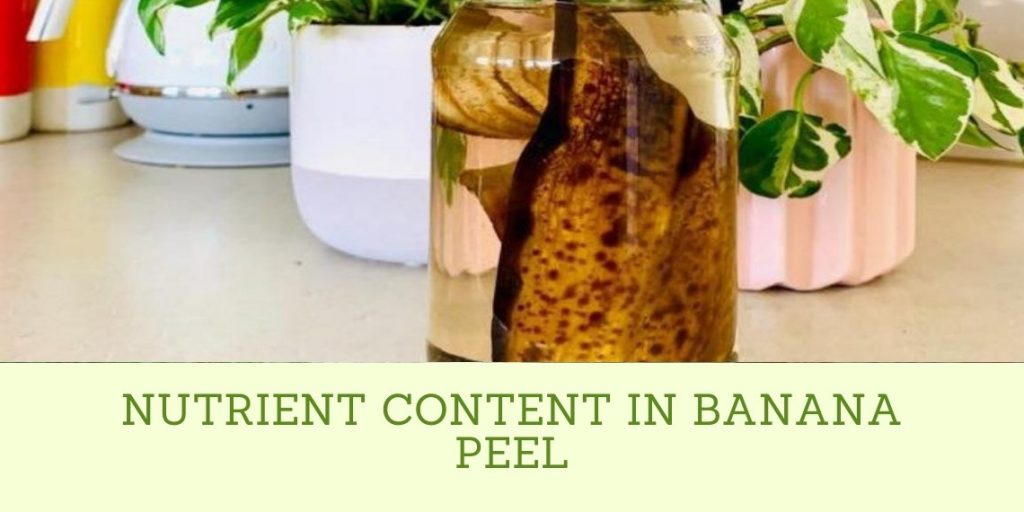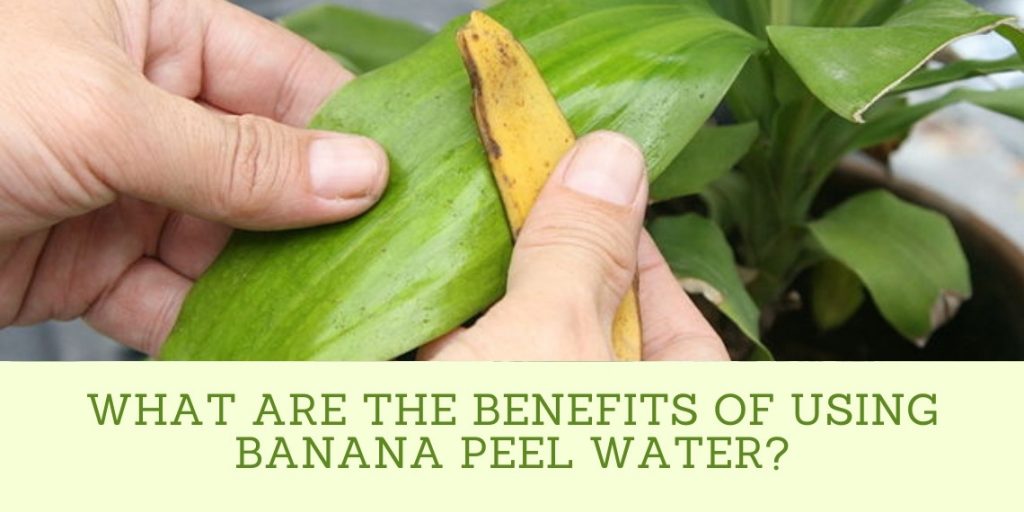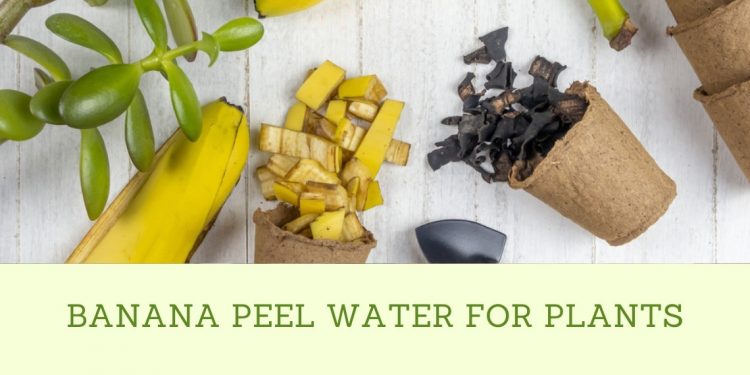It is widely believed that banana peel water can be used as a natural fertilizer for plants. Banana peel water is made by soaking a banana in water, similar to the way tea is brewed. The liquid from this process can be used as liquid fertilizer for plants and flowers.
According to some sources, it may contain ten times more nutrients than manure tea. Banana peel compost tea has been called “one of nature’s finest everbloom fertilizers.”
But is banana peel water useful to plants? And if so, how does it work, and what are the benefits of using banana peel water? Let’s find out!
What is Banana Peel Water?
Scientists have recently discovered that banana peel water is a great natural pesticide. Banana peels are rich in nutrients, so it’s no wonder that they offer several benefits to the environment.
Not only does this peel contain potassium, calcium, and magnesium – all of which help crops grow faster-but it also contains yeast. These nutrients make for a perfect fertilizer.
The yeast contained in the banana peel water acts as a pesticide because it emits ethanol which kills larvae and other pests. The banana peel also contains tannic acid, an organic plant compound that protects against mold, fungi, mildew, and insects.
You can drop your peels into the soil of your favorite plants to keep them healthy for up to a month.
You can also add your peels to the soil when you are growing vegetables. The potassium and magnesium will encourage healthy plant growth, while the yeast in the peel will keep pests away from your plants.
Simply add half of a banana peel per planting hole when you transplant, and be sure not to remove it until harvest time.
What You Need to Know
Banana peels contain potassium which helps maintain plant health by providing nutrients to roots and reducing soil-borne diseases such as root rot. The high potassium content also makes bananas an excellent choice for fertilizing acid-loving plants like azaleas and blueberries.
Banana peels make great compost fodder because they break down quickly and release nitrogen into the soil (nitrogen is essential in all forms of life). They also help control pests, keeping your garden free from unwanted insects, flies, mites and slugs.
Nutrient Content in Banana Peel

The banana peel contains a number of nutrients that are beneficial for plant growth. In particular, it contains potassium and magnesium, two minerals that are essential for healthy plant growth.
It also includes vitamins B6 and C as well as thiamine, riboflavin, niacin and folates. Further research is needed to identify all the components in the banana peel and their individual impact on plant growth.
In addition, the banana peel contains a number of other beneficial substances such as pectin, cellulose and hemicellulose. In fact, this is one of the reasons why many gardeners add banana peels to compost heaps for making fertilizer. Banana peel water is rich in potassium and magnesium.
These nutrients improve the health of plants that require neutral or alkaline soil PH levels. Potassium deficiency describes a condition that is characterized by yellowing leaves and stunted growth, which may lead to plant death if not treated soon enough.
Banana peel water also contains Vitamins B6 and C as well as thiamine, riboflavin, niacin and folates.
All these substances are known to be beneficial for plant growth. Banana peel water can therefore be used as a natural organic fertilizer in place of chemical fertilizers that may prove harmful to the soil when over-applied. Some people also believe that they can help keep pests away from their garden.
How To Prepare Banana Peel Water?
To prepare banana peel water, you simply need to slice a few banana peels into smaller pieces and soak them in a bucket of water overnight. After 8 hours, you can then use the resulting liquid as a safe organic fertilizer for plants.
You should remove the banana peels before using the water. However, note that you can still use this method to feed your plants if you leave the banana peels in the water overnight.
Banana peel water is best used on flowers and plants that require alkaline soil PH levels. The banana peel water solution must be diluted with four parts of water before use. Using it undiluted may burn plants and spoil fruits.
So far, no adverse side effects have been reported from using banana peel water either as a fertilizer or as a pesticide. Banana peels contain all the necessary nutrients for healthy plant growth, including potassium and magnesium. All these are essential for alkaline soil PH levels.
In addition to that, the banana peel water will not contaminate groundwater. The reason for that is it breaks down into fertilizer components that are safe for plants and do not pollute the environment.
What Is Banana Peel Water Used For?
There are several reported uses of banana peel water, but all have differing degrees of success. Here are some examples:
As a fertilizer for plants
This is the belief that has led to many people using banana peels as organic plant food. While this practice has been used by farmers and gardeners alike, scientific studies do not show any significant difference in crop yield when banana peel water is used.
As a pesticide
Banana peels and skin can be used as part of an all-natural pesticide, though its effectiveness has been questioned. It may work better as a compost additive by increasing microbial action that leads to the breakdown of other pollutants like pesticides and oil spills.
As a weed suppressant
Banana peels produce potassium which is an element that promotes plant growth. Therefore, it has been used to prevent weed growth! You can spread a thick layer of banana peel at the base of the plant, and this will suppress weed growth without harming your crop.
As a compost
Banana peels contain proteins and carbohydrates, making them perfect for composting –turning them into nutrient-rich plant fertilizer. They are also high in potassium, as mentioned, which is an important plant nutrient.
What Are the Benefits of Using Banana Peel Water?

There are many benefits of using banana peel water. It’s a natural, organic and eco-friendly way to add nutrients to your plants and garden. The following article will explore some of the most popular benefits of using this kind of fertilizer.
- Banana peel water is a cheaper alternative to store-bought fertilizers that can be up to 4 times more expensive than using banana peels.
- It also increases the quality of soil by adding potassium, magnesium, iron and sulfur while leaving behind nitrogen which can be detrimental in some instances (i.e., beans).
- Using this type of fertilizer will help keep pathogens out by providing a layer between it and the roots.
- Banana peels that are allowed to decompose will also provide microorganisms that can help fight off pathogens.
- Banana peels naturally repel some types of harmful insects, which means you won’t need to spend more money on pesticides.
- Banana peel water is completely natural and organic for your plants and garden, making it a sustainable solution in comparison with artificial fertilizers.
- It will also help to cut down on the amount of food waste you dispose of since banana peels are typically wasted after eating a single banana.
- Banana peel water has been used for generations by gardeners and farmers alike, meaning it’s something that is already proven to work rather than some new product or novel idea without any scientific backing.
- It’s possible to extract the water from the banana peels in order to create a concentrate, which can be used even more sparingly.
Because of all these benefits, it’s clear that using banana peel water for plants is one of the best natural fertilizers out there, and it’s easy to make right at home.
Using Banana Peel Water to Feed Plants
Banana peel water can also be used to feed plants. But does it work? And if so, how do you prepare a banana peel for plant feeding?
Well, banana peels contain about 5% of their mass as potassium and 0.25% as nitrogen (this ratio is not very different from other organic fertilizers such as seaweed or animal manures).
Of course, plants need nitrogen to grow, but studies show that potassium is more important. The key, then, is to find the right balance of K/N for plant feeding.
Too much nitrogen will result in lush green leaves but very few fruits, while too little K will cause the plants’ leaves to turn yellow and drop. Obviously, the banana peel has to be left in one piece; if you cut it into pieces, they won’t work.
Preparation
Here’s how you can prepare them for feeding plants:
- Fill a 5-gallon bucket halfway with water and drop in 8 oz. of the whole, unpeeled banana peels (if your plant is smaller, use less; if it’s bigger, use more).
- Stir everything to mix well.
- Leave the banana peels in the bucket for a week or so, and then pour the mixture into your plant’s soil.
The amount of water you have to add depends on how heavily your plant is feeding on its roots. In general, a 5-gallon bucket will be enough to feed a plant with a 1′ diameter root ball.
If you’re looking for a simple, organic and natural fertilizer for your plants, banana peel water is a perfect choice! You can make it yourself or buy it from any local nursery.
The 8 oz. example mentioned above should last you through several feedings, so one bucket will be enough to keep your plant happy for months.
Using Banana Peel Water to Water Succulents
Many people love to grow their succulents, but the hard part is watering them. Most people are worried about overwatering their plants, but there are also some who are worried about under-watering them.
Luckily, there’s a solution for both problems. Banana peel water can be used to water your succulents because it has enough nutrients for the plant to thrive.
You can either use the peels or the flesh, but they both work equally as well. Just make sure to chop up all the peels into small pieces before putting them in a pot of water.
Make sure that they are completely submerged in water for about 4 days until you notice that the bananas have begun to ferment. When this happens, it is a sign that the banana peels have had enough time to leach all of their nutrients into the water.
Once you see this, you can strain them and put them in a spray bottle to use as water for your plants. It’s best if you use this directly on your plants instead of adding it to your soil.
This will make the plants much healthier, and they will grow faster. It can also be used as a fertilizer to make them even healthier. The best part about this is that it’s completely safe for your plants because it has no chemicals either.
Make sure to keep the water in a dark place and use all of it within 24 hours. It’s best to use this right after you make it, and it will give your plants a great boost of nutrients.


